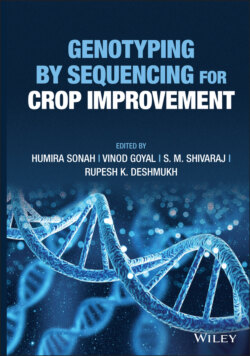Читать книгу Genotyping by Sequencing for Crop Improvement - Группа авторов - Страница 17
1.3.1.2 Diversity Array Technology (DArT™)
ОглавлениеThis is a high‐throughput DNA polymorphism analysis method which combines microarray and restriction‐based PCR methods. It is similar to AFLP where hybridization is used for the detection of polymorphism. It can able to provide a comprehensive genome coverage even in those organisms not having genome sequence information (Jaccoud et al. 2001). Diversity array technology (DArT) is a solid‐state open platform method for analyzing DNA polymorphism. DArT procedure includes (i) Generating a diversity panel and (ii) Genotyping using a diversity panel. The diversity panel is generated using a set of lines representing the breadth of variability in germplasm (~10 lines). An equal quantity of DNA from each representative line is pooled followed by restriction with two to three restriction endonucleases (REs) and ligation of RE‐specific adaptors. Later DNA fragments are amplified using adaptor complementary primers. The representation fragments are ligated to vector and transformed into Escherichia coli cells. The transformed cells with recombinant DNA are selected and amplified using M13 forward and reverse primer. The amplified DNA is isolated and purified. The purified DNA is coated onto polylysine‐coated glass slides to generate a diversity array.
For genotyping, the representation fragments of the target genotypes are prepared in the same as in the diversity panel. The DNA fragments are column purified and fluorescently labeled with two different dyes (Cy3 or Cy5). The labeled DNA fragments are used for hybridization onto the diversity array. Two representative panels – one labeled with Cy3 and another with Cy5 – can be hybridized simultaneously and hybridization signal intensities are measured for each spot. DArT, thus detects DNA polymorphism at several hundred genomic loci in a single array without relying on sequence information.
